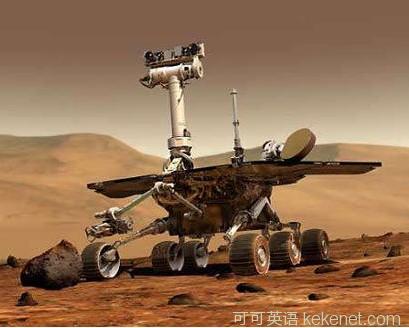
Science and Technolgy
科技
Mars exploration
探測火星
How to land a Mini on Mars
如何讓一輛微型汽車大的探測器在火星著陸
The biggest and fanciest Mars rover so far will soon blast off from Florida
迄今為止最昂貴、最大的火星漫游者將很快從佛羅里達發射升空
EARTH excepted, the most probed and prodded planet in the solar system is Mars. Besides the assortment of craft that have flown by it or gone into orbit around it, three robotic buggies equipped with cameras and scientific instruments have roamed the Martian surface on behalf of NASA, America's space agency, since 1997.
除了地球,火星是太陽系里被人類探索得最多、最讓人感到刺激的行星。除了各種飛過它的以及進入它附近軌道的飛船外,從1997年開始,三個裝配了相機和科學儀器的探險車已經代表美國太空機構NASA漫游了火星表面。
If all goes according to plan, they will soon be joined by a fourth. On November 26th a new rover, Curiosity, will ascend from Cape Canaveral. If it gets there in one piece, it will examine the climate and geology of Mars and look for any signs of life that might have arisen.
如果所有一切都按計劃進行,第四個將探險車將很快加入其中。11月26日,新的漫游者"好奇號"將從卡拉維拉爾角發射升空。如果它完好無損地抵達,它將考察火星氣候和地質,并尋找可能出現的生命跡象。
The first of NASA's rovers, Sojourner, which reached Mars in 1997, was 65cm long and weighed (on Earth, where the gravitational pull is 2? times Mars's) 10kg. Spirit and Opportunity, its twin successors, were larger, at 1.6 metres and 170kg. Curiosity, by comparison, is a monster. At 3 metres and 900kg it is the size of a small car. It also uses different technology. The other three rovers were powered by solar panels. Curiosity is powered by plutonium. (Not a full-scale reactor, but a generator that turns the heat of radioactive decay into electrical energy.) This brings three advantages. First, it allows Curiosity to carry more power-hungry scientific instruments than previous rovers. Second, it permits the rover to work through the Martian winter. Third, it avoids the problem of dust accumulating on the solar panels, which gradually sapped the strength of its predecessors.
1997年,NASA的火星漫游者"旅居者"到達火星,它長65厘米,重10千克(地球引力是火星的2.5倍)。其繼任者,雙胞胎"勇氣和機遇號"比它更大(1.6米、170千克)。相比之下,"好奇號"就是個怪物。其3米長、900公斤重的尺寸就像一部小汽車。它也有不同的技術,之前漫游者由太陽能面板提供能量,"好奇號"由钚驅動(不完全是反應堆,而是一個將放射衰變產生的熱能轉換成電能的發電機)。這有三點好處:1、比起之前的漫游者,它能讓"好奇號"帶上更多的能耗大的科學儀器;2、它允許漫游者在火星冬季保持運轉。3、它能避免讓前幾個漫游者的能量逐漸損耗的太陽能面板積土問題。
Curiosity's size makes getting it safely onto the Martian surface tricky. Previous rovers have deployed parachutes to slow their descents, and have then crashed into the ground using airbags to cushion their impacts. Curiosity is too massive for that approach to work. Instead, NASA hopes to deposit it on Mars using a contraption it has dubbed a skycrane.
"好奇號"的尺寸使之能在火星復雜表面安全著陸。以前,漫游者打開降落傘減慢下降速度,在撞向地面時用安全氣囊緩沖。"好奇號"大到這樣的方法不能起作用。相反地,NASA希望利用一種精巧的被稱為"天空起重機"的裝置使其在火星著陸。
As with the other rovers, Curiosity's mother ship will rely on heat shields and air-resistance, and then on a parachute, to slow its arrival. But at an altitude of 1.6km a specially designed descent stage bearing the rover will drop away from this vehicle. The descent stage has eight rocket motors on its corners. These will slow its fall to a relatively sedate 0.75 metres a second. When it is about 20 metres above the surface, the rover will be lowered from it on wires and deposited gently onto the Martian landscape. The cables will then be cut with explosives, the descent stage will fly off and crash land elsewhere, and Curiosity will begin its mission.
像其它幾個漫游者一樣,"好奇號"的母船將依靠隔熱、耐大氣摩擦的防護層,然后通過降落傘減速。但在1600米高時,一個特別設計的背負著漫游者的下降臺從母船脫落,下降臺的四角有8個火箭發動機,這些發動機把速度降到相對緩慢的0.75米/秒。離地約20米時,它將綁在線纜上的漫游者放下去,輕輕地在火星著陸。之后這些線纜將通過爆破切斷,下降臺飛走并在其它地方墜毀,"好奇號"開始它的任務。
That, at least, is the theory. But the skycrane has never been used before, and there is plenty else that could go wrong. Indeed, Mars has something of a reputation for destroying spacecraft. Around half the missions sent there since the first Soviet attempts in 1960 have failed to arrive. A conversation on the subject in 1964, between a journalist and John Casani, a NASA scientist, spawned the idea of a Great Galactic Ghoul, a malevolent creature that prowls the space-lanes between Earth and Mars, dining on unfortunate spacecraft.
這至少還是理論。除"天空起重機"從未用過外,可能出岔子的地方還有很多。火星有著宇宙飛船毀滅者的名聲,自1960年蘇聯第一次嘗試以來,約一半的登陸任務已經失敗。1964年,NASA科學家約翰·卡薩尼與一名記者就這個問題有過一次對話,并得出了"星系食尸鬼"的概念——一個險惡的、徘徊在地球與火星之間航線的、以不幸的宇宙飛船為食的家伙。
The ghoul's latest victim appears to have been Phobos-Grunt, an ambitious Russian mission that was intended to return to Earth with a rock sample from Phobos, the larger of Mars's moons. The Russian space agency's engineers lost contact with it soon after its launch on November 8th. Limited contact had been re-established as The Economist went to press, but it is not clear whether the mission can be salvaged. NASA's engineers, rationalists though they be, will be keeping their fingers crossed on Saturday, and hoping that the ghoul's appetite has thus been sated, and that it will leave Curiosity alone.
最近一個亡于"食尸鬼"的似乎是俄羅斯的"福布斯—土壤"。一個雄心勃勃的打算把火星較大一顆衛星——火衛一的巖石標本帶回地球的任務。11月8日,在發射不久,俄羅斯太空機構的工程師與它失去了聯系。本刊截稿時,他們已經重新建立起有限的聯系。盡管是理性主義者,NASA的工程師還是會在周六祈禱,希望"食尸鬼"的胃已經填飽了,而不去理睬"好奇號"。











